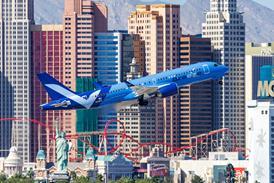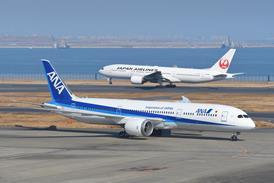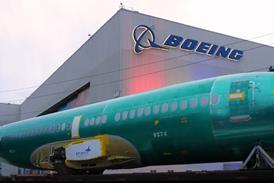Struggling with a weak fare environment, Frontier is forging ahead with its business plan, adding new aircraft and striving for more gates in Denver
There is no doubt that what happens to United Airlines - the primary competitor for Frontier Airlines at its Denver base - will substantially affect future operations for the low-fares carrier. But it is not exactly playing a waiting game.
Frontier is already engaged in an ambitious aircraft replacement plan to switch to a new Airbus fleet, equipped with seat-back satellite television. It is also adding new flights, especially to key western destinations such as San Diego and San Francisco, and has in place a new partnership to provide regional jet services to augment the mainline services. Frontier is also moving on the marketing front. This spring it overhauled an already simple fare structure to feature just six sharply reduced, unencumbered fares, and plans a comprehensive new branding campaign.
Nevertheless, United's bankruptcy has already put on hold a planned $270 million expansion by the Denver hub, which would have seen 10 much-needed extra gates for Frontier. And as United teetered on the brink of bankruptcy, it undermined Frontier's unique appeal to the discretionary and business traveller by matching its rival's lower fares for close-in bookings without restrictions.
United uncertainties
As United goes through the bankruptcy process, it could decide to pull back capacity at Denver or use the airport as a base for the low-cost carrier it talks about creating. It could leave its Denver operations intact - as it has so far - or even decide to expand there. In 2002, United had a 61% capacity share at the airport, its most highly concentrated hub. At the other extreme, some think United may not make it at all in the long term.
"We spend a lot of time thinking about various scenarios," says Jeff Potter, Frontier's president and chief executive. "We want to be prepared for any type of scenario that might present itself."
He admits that whatever United ends up doing, there will be ramifications for Frontier. "But by the same token, you have to be focused on your day-to-day business, so operationally it has not affected us," Potter adds. "In fact, I would say over the last 12 months, we're operating the best airline we ever have."
Frontier has 180 flights a day in and out of Denver to 37 cities, including five served exclusively now by its regional jet partner, Frontier JetExpress, operated by Mesa Air Group. Frontier's network extends from coast to coast and includes most major US cities and two Mexican destinations - Cancún and Mazatlan.
The airline operates a fleet of 36 narrowbody aircraft in transition as it moves from Boeing to all-Airbus. At the start of May, Frontier began the summer season with 17 Airbus A319s, acquired over the last two years, and 19 Boeing 737s. Through to March 2004, it will take delivery of 11 more Airbus aircraft - including four of five A318s on order - and retire 10 737s.
Frontier, which styles itself a full-service, "affordable fare airline", offers a single class of service. Its new 132-seat A319s have unusually well-cushioned economy seats and a spacious 33in seat pitch, compared with 31-32in on the 737s. The aircraft are also equipped with the 24-channel DirectTV programming offered through LiveTV.
Nine years old in July, the airline had a wild and woolly start that more than lived up to its pioneering name. The carrier at first picked what it soon realised were all the wrong routes - such as Bismarck and Minot in North Dakota. It also faced what it alleged was predatory pricing by United. After a while, though, a restructured route system began to work and, from 1999, Frontier was profitable for four fiscal years in a row.
Now, however, the airline expects to report a loss in the first three months of this year - its fourth consecutive quarterly loss - and for its fiscal year ending March. The poor economy, concern about the war in Iraq, weakened travel demand, high fuel prices and the difficult fare environment have all taken their toll. As if that were not enough, an unusually severe blizzard in March shut Denver's airport for two full days, causing Frontier to cancel 371 flights during one of its best travel periods.
Unit cost
There are bright spots however. In the last quarter of 2002, Frontier's unit cost fell 11% to 5.1¢ per seat kilometre (8.28¢ per mile) - 16% if fuel is excluded. Its traffic growth of 71% outstripped a 51% capacity increase, and its aircraft utilisation was up sharply.
"We've been very successful maintaining and improving on our unit cost, and we see further improvements going forward as we get through the Airbus transition, and hopefully fuel prices will play a hand in that," Potter says.
Unfortunately, however, the revenue side has not been as promising. In the same quarter, passenger yield decreased almost 24% while the airline's average fare fell to $111 from $134 a year earlier. The basic reason is aggressive discounting by United, among others, as they attempt to fill seats at any price - fares, Potter maintains, that cannot possibly cover their costs. "It's a very tough challenge right now," he says. "You find yourself competing with some carriers that appear to be market share driven as opposed to profitability driven. Market share does not pay the bills."
Potter says Frontier was carefully structured so that it could survive through a serious downturn. "We tried to develop a plan for this company that even in the worst of times would be at least break even, and I think we have," Potter says. "Our only problem was no-one - no-one - ever could have contemplated what the worst of times would bring."
Still, Potter and his management team are optimistic that the company is positioned to weather the storm. In the last few months, the airline took steps to assure adequate liquidity through a continuing difficult environment. One was to close on a $70 million commercial loan facility - $63 million of which is guaranteed by the US Air Transportation Stabilization Board. It also completed a sale/leaseback transaction of an A319, raising $7 million, and received a prepayment of $10 million from a marketing vendor for an upcoming programme.
As a result, Frontier is expected to report unrestricted cash on hand of about $100 million as of 31 March, up from $31.5 million at the end of 2002. "Our liquidity position has been significantly improved," says Paul Tate, Frontier's chief financial officer. In December, Frontier also embarked on a fuel hedging programme that has paid off handsomely, Tate says. The airline is 20% hedged through 2003.
Tate also expects aircraft transition expenses - particularly pilot training costs - to peak in its current fiscal year as Frontier adds 10 Airbus and eliminates 10 Boeing aircraft. By next March, its fleet will consist of 28 Airbus aircraft and nine Boeing 737-300s, with the remaining 737s out of the fleet by early 2006. "One of our objectives is to get to one fleet type as quickly as we can because we want to realise the associated cost benefits," he says.
The transition to Airbus has already improved the carrier's aircraft utilisation - it was just under 10h in the last quarter of 2002, up 2h from a year earlier - and is set to improve further this year. Its three remaining admittedly relatively unreliable 737-200s leave the fleet by August, Tate adds.
After deliveries this year, Frontier has four remaining Airbus aircraft on firm order to be delivered in 2004, but it has options and expects additional orders could be accommodated. "We want to remain as flexible as possible with our fleet," Tate says. Although Frontier executed its business plan fairly consistently since 11 September - delaying no aircraft deliveries, growing at Denver and eschewing lay-offs - the magnitude of future growth will be heavily affected by what happens to United in Denver, he says. "We could grow fairly substantially or we could grow fairly conservatively."
Specialised role for A318
Although the A318 has not set any order records for its manufacturer, Frontier says it will fill an important niche out of Denver. The 114-seat A318 will be used for thinner markets, such as Omaha, Albuquerque and Salt Lake City, or low-season routes such as certain Florida summer destinations. The markets - some were served by 119-seat 737-200s - do not need a 132-seat A319, but require more than a regional jet, which also has range limitations from the hot and high Denver airport, Tate says.
The operating and ownership costs of the A318s are also roughly 10% lower than the A319, Tate adds. "There are thinner markets where that 10% makes a big difference." Frontier's A318s will be powered by a version of the CFM International CFM56 engine that powers its A319s. Frontier also has a new agreement with Mesa Air Group, its Frontier JetExpress operator, to provide regional jet flights to replace mainline services on some routes and supplement them on others. The new fee-for-departure agreement replaces a pro-rata route relationship that both agreed was not working.
Beginning last month, Mesa took over Frontier routes to Tucson, Wichita, Ontario, Oklahoma City and Boise using five 50-seat Bombardier CRJ-200s. "We were able to take mainline equipment out and redeploy them to larger markets, adding service to Seattle, San Francisco, Portland, San Diego, Phoenix and Dallas," says Sean Menke, Frontier's vice-president marketing and planning.
The regional jets also supplement mainline flights to San Jose, Austin and Albuquerque to give Frontier added frequency at times when larger aircraft are not required. "If we're going to carry 40 people, I prefer to carry 40 people on a 50-seat aircraft than on a 132-seat aircraft," Menke says.
The simplified fare structure put in place in February appears to be working too. Frontier had been very successful in close-in bookings because of the disparity in pricing between it and United. "Because of its higher cost structure, United needs to get the higher yield, and our lower cost structure allows us to undercut their pricing structure, which stimulates demand for us," Menke says. A lot of that disappeared though when United matched Frontier pretty much across the board.
New pricing
"We needed a creative way of getting the opportunity back, and using the cost structure to our advantage," he says. "The result was new pricing, with six reduced fares for each market; no one-way, city-pair fare over $499; and no Saturday-night, round-trip or advance-booking requirements." Because fares were lowered 25-77%, Frontier believes demand is being stimulated, especially in the important closer-in category.
Frontier is also launching a new branding campaign to create awareness in the Denver and Colorado communities for which Frontier is the hometown airline, that it is not the "old" Frontier - an airline acquired by People Express in 1986 - and not the Frontier of 1994. "People have to understand that we are a coast-to-coast carrier," Menke says. "We are a niche carrier, but we now provide new Airbus aircraft, DirectTV on board, a good product, including food service, good fares, and we are a friendly airline."
Frontier is going to discard its "Spirit of the West" marketing theme but will retain and capitalise on the distinctive tails that set its aircraft apart at airports. They feature striking pictures of wildlife native to the continental USA, such as moose, pelicans, wolves, eagles, whales, bears and buffalo.
Fresh slots
Although it expects a 15% capacity boost this year, the only new market on the horizon is in Orange County, California, where Frontier is at the top of the new entrants list for access to slots at the highly restricted airport. It will also continue to look at opportunities in Mexico and possibly Canada, but expects primarily to concentrate on adding frequencies rather than new cities, at least for now.
Frontier has no current plans to develop a second hub, a new focus city or to start point-to-point routes bypassing Denver, but that could change. "Our focus is going to continue to be on Denver," says Potter, "but we are always looking at new opportunities."
The airline's operations are seriously hampered by a lack of gates, even as growth aircraft arrive. Frontier leases 10 gates but operates up to 14 daily, using international gates or borrowing those of other carriers.
The airport plan to build Frontier 10 more gates was delayed after United's bankruptcy filing on the assumption that United might give up eight, under-utilised gates in the concourse Frontier uses, and move those operations to its exclusive 47-gate concourse.
"We're operating what I would characterise as a sub-optimal schedule because of the facility constraints, so it costs us," Potter says. "If we continue down the path of trying to fit into a facility that is not conducive to our growth, then we have to take that into consideration when evaluating other opportunities. They can start moving up on the list."
Source: Airline Business























